六年级英语上册(牛津上海版深圳)Unit 5《Animals in danger》(第二课时)公开课课件
- 格式:ppt
- 大小:5.89 MB
- 文档页数:41
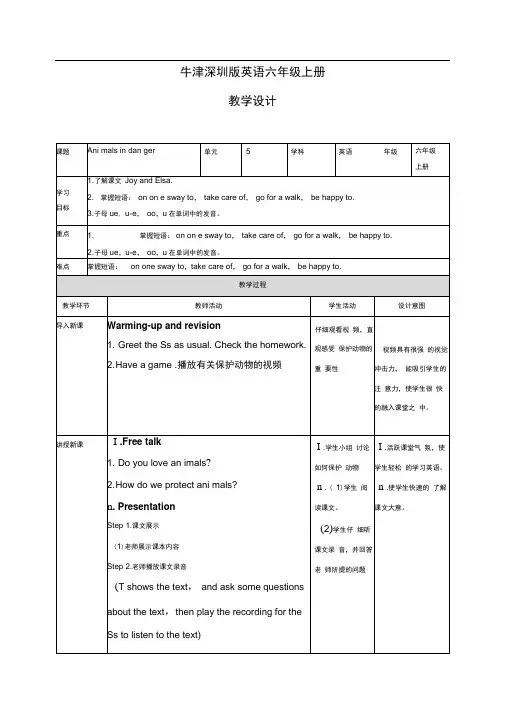
牛津深圳版英语六年级上册教学设计Step 1(1)on onesway to 在某人去...的路上(当to后跟介词时,to要省略。
) 在Tom去学校的路上,他发现了一只小猫。
On Tom's way to school, he finds a little cat. 在她回家的路上,她遇到了一个同学。
On her way home she meets a classmate. (2)take care of 照顾take care of =look after你应该照顾好她。
You should take care of her well.=You should look after her well. 他把弟弟照顾的很好。
He takes care of his little brother well.=He looks after his little brother well.(3) go for a walk 散步go for a walk=have a walk他经常晚饭后去散步。
He usually goes for a walk after supper. 她常常和父母一起去散步。
She ofte n has a walk with her pare nts.(4)be happy tobe happy to do sth 咼兴做某事他很咼兴去帮助别人。
He is very happy to help others. 我们很咼兴去保护动物。
We are very happy to protect ani mals. Step 2课堂练习将下列句子翻译成英语。
(1)在他回家的路上,他看到一些人正在踢足球。
(2)我们应该照顾好我们的父母。
(3)Tom经常在公园里散步。
(4)我很高兴帮我妈妈去购物。
Step 2 Ask and an swer(1)What did Joe do ?(2)Why did Joe take care of Elsa ?川.(1)学生根据例句。
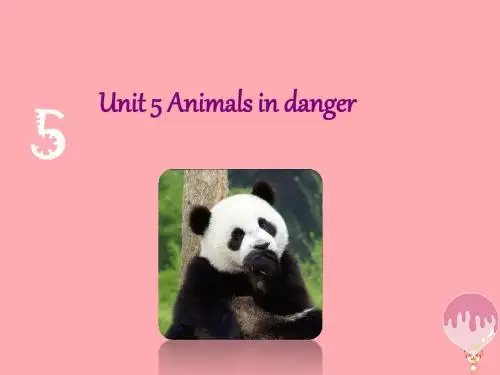
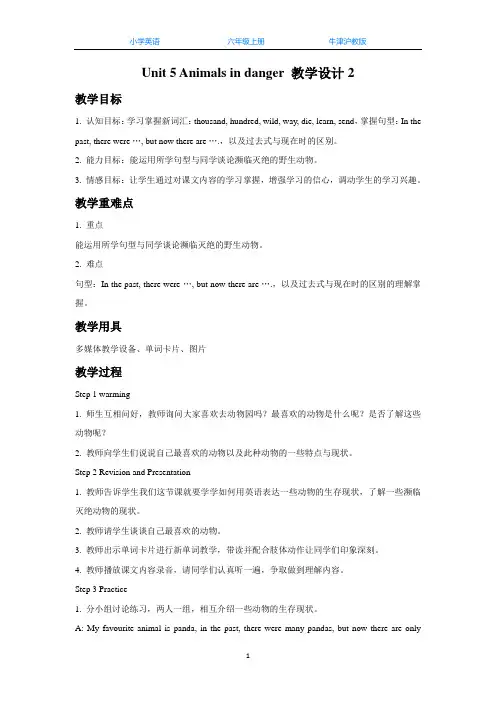
Unit 5 Animals in danger 教学设计2教学目标1. 认知目标:学习掌握新词汇:thousand, hundred, wild, way, die, learn, send,掌握句型:In the past, there were …, but now there are ….,以及过去式与现在时的区别。
2. 能力目标:能运用所学句型与同学谈论濒临灭绝的野生动物。
3. 情感目标:让学生通过对课文内容的学习掌握,增强学习的信心,调动学生的学习兴趣。
教学重难点1. 重点能运用所学句型与同学谈论濒临灭绝的野生动物。
2. 难点句型:In the past, there were …, but now there are ….,以及过去式与现在时的区别的理解掌握。
教学用具多媒体教学设备、单词卡片、图片教学过程Step 1 warming1. 师生互相问好,教师询问大家喜欢去动物园吗?最喜欢的动物是什么呢?是否了解这些动物呢?2. 教师向学生们说说自己最喜欢的动物以及此种动物的一些特点与现状。
Step 2 Revision and Presentation1. 教师告诉学生我们这节课就要学学如何用英语表达一些动物的生存现状,了解一些濒临灭绝动物的现状。
2. 教师请学生谈谈自己最喜欢的动物。
3. 教师出示单词卡片进行新单词教学,带读并配合肢体动作让同学们印象深刻。
4. 教师播放课文内容录音,请同学们认真听一遍,争取做到理解内容。
Step 3 Practice1. 分小组讨论练习,两人一组,相互介绍一些动物的生存现状。
A: My favourite animal is panda, in the past, there were many pandas, but now there are onlyabout one thousand six hundred pandas in the wild.B: My favourite animal is blue whale, in the past, there were many blue whales, but now there areonly about ten thousand in the wild.2. Let’s learn and sing a song: All animals bright and beautiful.Step 4 Summary教师根据本课时所学内容进行回忆总结,并请同学们谈谈本节课印象最深刻的环节。
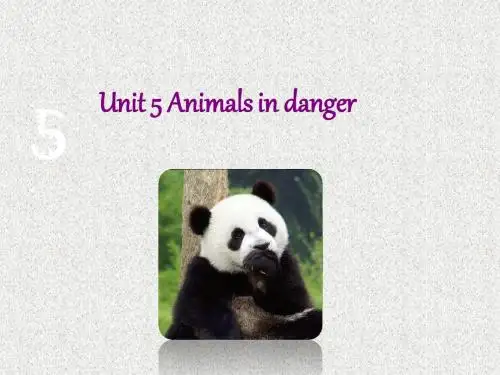
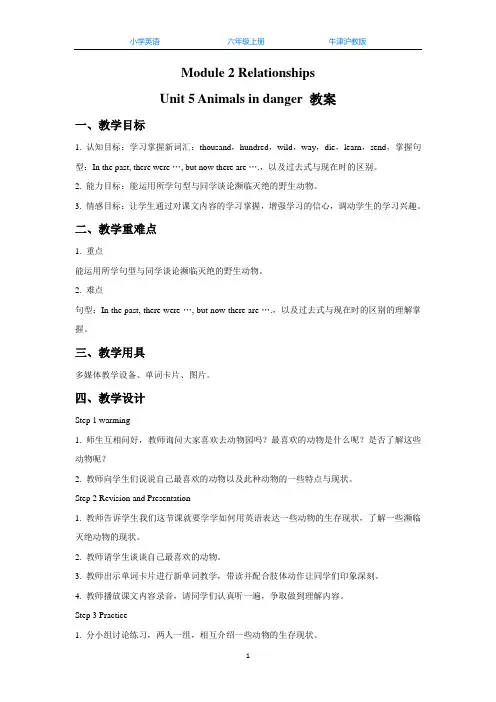
Module 2 RelationshipsUnit 5 Animals in danger 教案一、教学目标1. 认知目标:学习掌握新词汇:thousand,hundred,wild,way,die,learn,send,掌握句型:In the past, there were …, but now there are ….,以及过去式与现在时的区别。
2. 能力目标:能运用所学句型与同学谈论濒临灭绝的野生动物。
3. 情感目标:让学生通过对课文内容的学习掌握,增强学习的信心,调动学生的学习兴趣。
二、教学重难点1. 重点能运用所学句型与同学谈论濒临灭绝的野生动物。
2. 难点句型:In the past, there were …, but now there are ….,以及过去式与现在时的区别的理解掌握。
三、教学用具多媒体教学设备、单词卡片、图片。
四、教学设计Step 1 warming1. 师生互相问好,教师询问大家喜欢去动物园吗?最喜欢的动物是什么呢?是否了解这些动物呢?2. 教师向学生们说说自己最喜欢的动物以及此种动物的一些特点与现状。
Step 2 Revision and Presentation1. 教师告诉学生我们这节课就要学学如何用英语表达一些动物的生存现状,了解一些濒临灭绝动物的现状。
2. 教师请学生谈谈自己最喜欢的动物。
3. 教师出示单词卡片进行新单词教学,带读并配合肢体动作让同学们印象深刻。
4. 教师播放课文内容录音,请同学们认真听一遍,争取做到理解内容。
Step 3 Practice1. 分小组讨论练习,两人一组,相互介绍一些动物的生存现状。
A: My favourite animal is panda, in the past, there were many pandas, but now there are onlyabout one thousand six hundred pandas in the wild.B: My favourite animal is blue whale, in the past, there were many blue whales, but now there areonly about ten thousand in the wild.2. Let’s learn and sing a song: All animals bright and beautiful.Step 4 Summary教师根据本课时所学内容进行回忆总结,并请同学们谈谈本节课印象最深刻的环节。
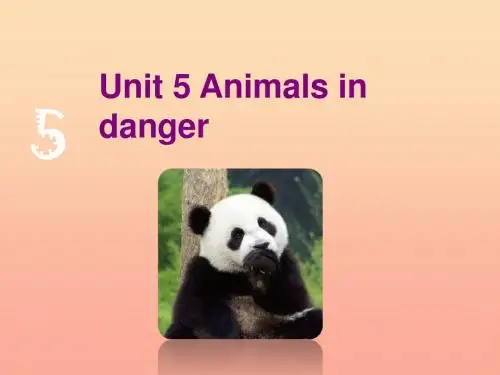
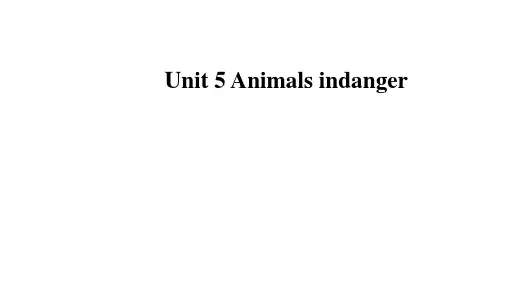
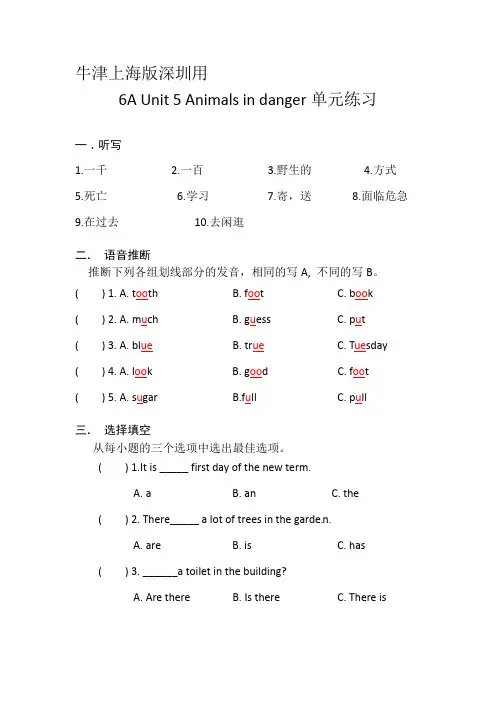
牛津上海版深圳用6A Unit 5 Animals in danger单元练习一.听写1.一千2.一百3.野生的4.方式5.死亡6.学习7.寄,送8.面临危急9.在过去10.去闲逛二.语音推断推断下列各组划线部分的发音,相同的写A, 不同的写B。
( ) 1. A. t oo th B. f oo t C. b oo k ( ) 2. A. m u ch B. g u ess C. p u t( ) 3. A. bl ue B. tr ue C. T ue sday ( ) 4. A. l oo k B. g oo d C. f oo t ( ) 5. A. s u gar B.f u ll C. p u ll三.选择填空从每小题的三个选项中选出最佳选项。
( ) 1.It is _____ first day of the new term.A. aB. anC. the( ) 2. There_____ a lot of trees in the garde n.A. areB. isC. has( ) 3. ______a toilet in the building?A. Are thereB. Is thereC. There is( ) 4.There is a football ______the bed.. A. under B. at C. in( ) 5.I like _____, tigers and monkeys.A. catB. horseC. horses 四.情景问答依据所给情景选出适当的答语或问句。
( ) 1. -- Shall we go to the park?--__________A.Yes, we can.B.Good idea.C. No, I like. ( ) 2. -- What can we do ______ them?-- Protect them.A.helpB. helpingC. to help( ) 3. -- How are we going to get to Moon Park?-- Let’s ______to go there.A.by a taxiB. take a taxiC. by taxi ( ) 4. -- Do you know her?-- ________A.Yes, I am.B.No, I am not.C. Yes, I do. ( ) 5. --Did you wash my T-shirt?-- _________A.Yes, I do.B. No, I d on’t.C. Yes, I did.五.阅读理解i. 推断句子是否符合短文内容,相符的写A, 不相符的写B。
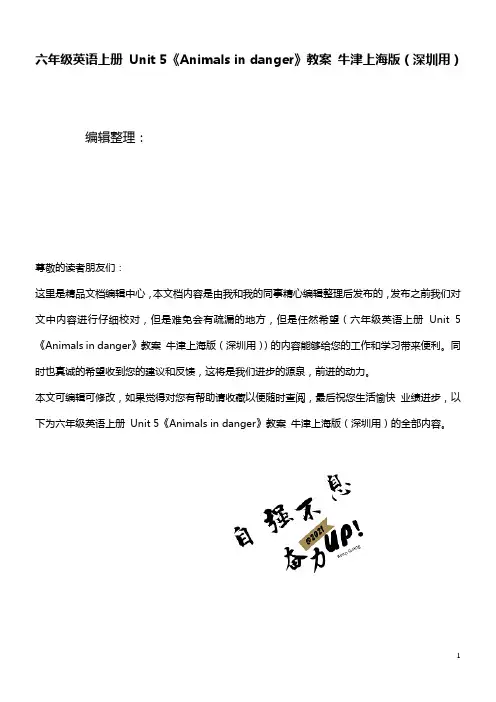
六年级英语上册Unit 5《Animals in danger》教案牛津上海版(深圳用)编辑整理:尊敬的读者朋友们:这里是精品文档编辑中心,本文档内容是由我和我的同事精心编辑整理后发布的,发布之前我们对文中内容进行仔细校对,但是难免会有疏漏的地方,但是任然希望(六年级英语上册Unit 5《Animals in danger》教案牛津上海版(深圳用))的内容能够给您的工作和学习带来便利。
同时也真诚的希望收到您的建议和反馈,这将是我们进步的源泉,前进的动力。
本文可编辑可修改,如果觉得对您有帮助请收藏以便随时查阅,最后祝您生活愉快业绩进步,以下为六年级英语上册Unit 5《Animals in danger》教案牛津上海版(深圳用)的全部内容。
Module 2 Unit 5 Animals in danger教案一、教学目标1. 认知目标:学习掌握新词汇:thousand,hundred,wild,way,die,learn,send,掌握句型:In the past,there were …, but now there are ….,以及过去式与现在时的区别。
2. 能力目标:能运用所学句型与同学谈论濒临灭绝的野生动物。
3. 情感目标:让学生通过对课文内容的学习掌握,增强学习的信心,调动学生的学习兴趣.二、教学重难点1。
重点能运用所学句型与同学谈论濒临灭绝的野生动物.2。
难点句型:In the past,there were …, but now there are …。
,以及过去式与现在时的区别的理解掌握三、教学用具多媒体教学设备、单词卡片、图片。
四、教学设计Step 1 warming1. 师生互相问好,教师询问大家喜欢去动物园吗?最喜欢的动物是什么呢?是否了解这些动物呢?2. 教师向学生们说说自己最喜欢的动物以及此种动物的一些特点与现状.Step 2 Revision and Presentation1. 教师告诉学生我们这节课就要学学如何用英语表达一些动物的生存现状,了解一些濒临灭绝动物的现状。
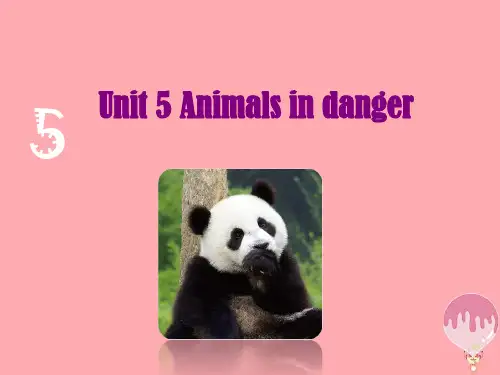
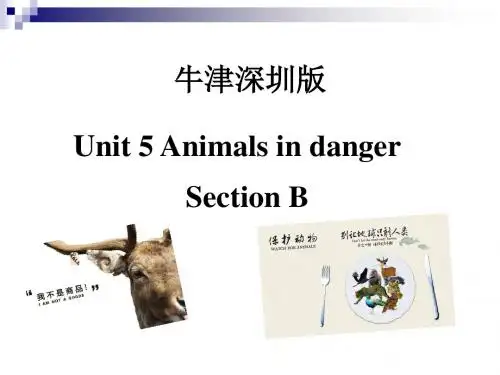
深圳牛津版小学六年级英语Unit5Animalsindanger教学设计深圳牛津版小学六年级英语第五单元Animals in danger教学设计教学目标设计一、教学内容概述(一)教学内容1、功能存在与不存在;数量:描述某种动物过去和现在的数量。
2、语言知识(1)核心句型和日常用语●In the past, there were many pandas.●What can we do to help them?(2)词汇Thousand, hundred, wild, way, die, learn, send, in danger, in the past, take care of, go for a walk, drive away(3)语音Ue, u-e, oo, u3、语言技能(1)听:听懂介绍濒危动物的短文,理解句型There was/were…的意思(2)说:用T here was/were…描述某样东西过去的数量(3)读●读懂关于濒危动物熊猫、华南虎和蓝鲸的介绍●读懂故事《乔伊和艾尔莎》,理解故事大意(4)写●能正确书写本单元的核心词汇●能正确书写本单元的核心句型(二)教学目标●能在语境中正确运用本单元的核心词汇●能根据字母u及字母组合ue、 u-e、oo的发音规律,拼读简单的单词。
●用T here was/were… 对某样东西过去的数量进行陈述●知道动物是人类的朋友,人类应该和动物建立良好的关系,要保护动物(三)教学重点●词汇:thousand, hundred, wild way, die, learn, send, in danger, inthe past, take care of, go for a walk, drive away●句型在:In the past, there were many pandas.●了解字母u及字母组合ue、u-e、oo 在单词中的发音。
牛津深圳版英语六年级上册教学设计Step 1(1)on onesway to 在某人去...的路上(当to后跟介词时,to要省略。
) 在Tom去学校的路上,他发现了一只小猫。
On Tom's way to school, he finds a little cat. 在她回家的路上,她遇到了一个同学。
On her way home she meets a classmate. (2)take care of 照顾take care of =look after你应该照顾好她。
You should take care of her well.=You should look after her well. 他把弟弟照顾的很好。
He takes care of his little brother well.=He looks after his little brother well.(3) go for a walk 散步go for a walk=have a walk他经常晚饭后去散步。
He usually goes for a walk after supper. 她常常和父母一起去散步。
She ofte n has a walk with her pare nts.(4)be happy tobe happy to do sth 咼兴做某事他很咼兴去帮助别人。
He is very happy to help others. 我们很咼兴去保护动物。
We are very happy to protect ani mals. Step 2课堂练习将下列句子翻译成英语。
(1)在他回家的路上,他看到一些人正在踢足球。
(2)我们应该照顾好我们的父母。
(3)Tom经常在公园里散步。
(4)我很高兴帮我妈妈去购物。
Step 2 Ask and an swer(1)What did Joe do ?(2)Why did Joe take care of Elsa ?川.(1)学生根据例句。